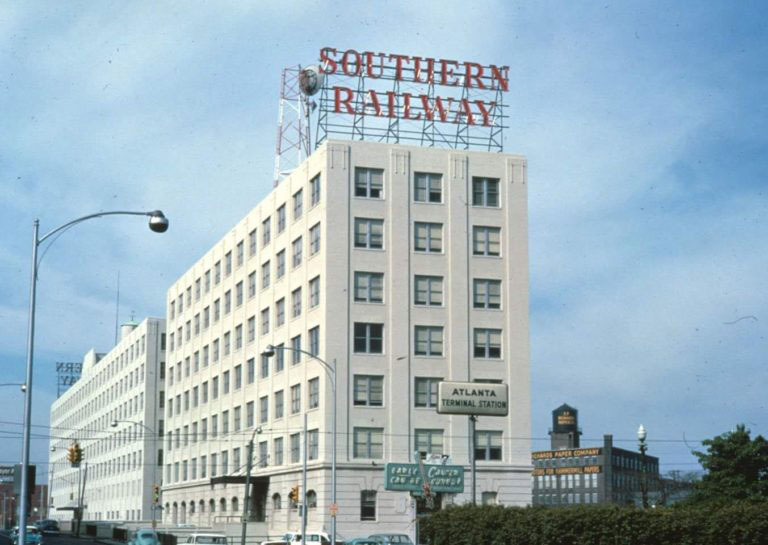
Railroad office buildings are not normally a subject covered so extensively as other aspects of railroading. I did not even think of them during my early years of rail-fanning, until I began my thirty year railroad career with Southern Railway in September, 1973.
The Southern Railway office complex was located on what was then Spring Street, SW in downtown Atlanta, Georgia. The concrete buildings were quite impressive. The east side of the buildings faced Spring Street, while the west side faced the Atlanta to Macon main lines of the Southern and Central of Georgia railroads. The buildings housed various departments including information technology, operations, car accounting, engineering (maintenance of way and structures) to name a few. I worked in the Bridge Department for twenty-nine years which was a part of engineering.
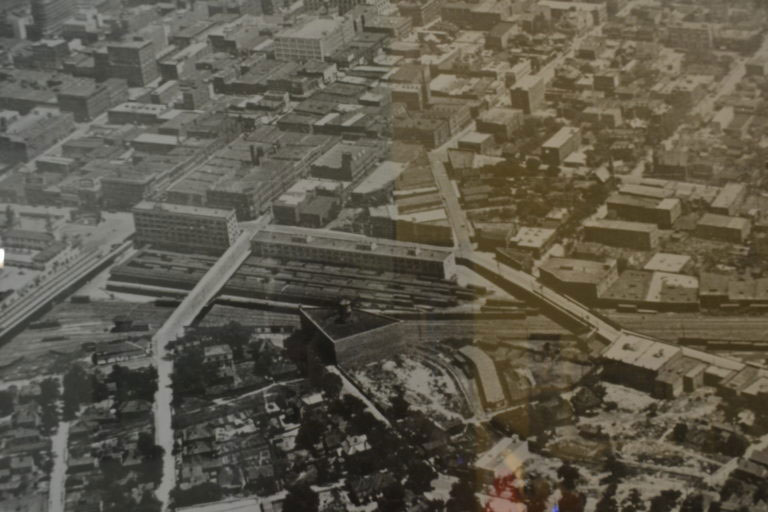
What became known by Southern Railway employees as the 99 and 125 buildings were constructed some time around 1912. They were bordered by Madison Avenue (some maps show it as Madison Street) on the east side and became known as the Madison Avenue Freight and Office Building. The 99 Building was at that time six stories high and contained offices. The 125 Building was three stories and served as a freight station. Nelson Street ran between the two buildings on a bridge, and the buildings were connected underneath the bridge.
In 1922, the City of Atlanta began construction of a viaduct that would open up Spring Street as a main traffic artery from today’s Amtrak’s Brookwood Station to the industrial district on the south side of downtown, the area where the Atlanta offices were located. The viaduct spanned the east-west railroad lines of the Western & Atlantic and the Georgia railroads. Ceremonies were held on December 20, 1923 to officially open the viaduct for traffic. The Spring Street Viaduct, joined an already elevated Madison Avenue, after which Madison Avenue, became Spring Street.
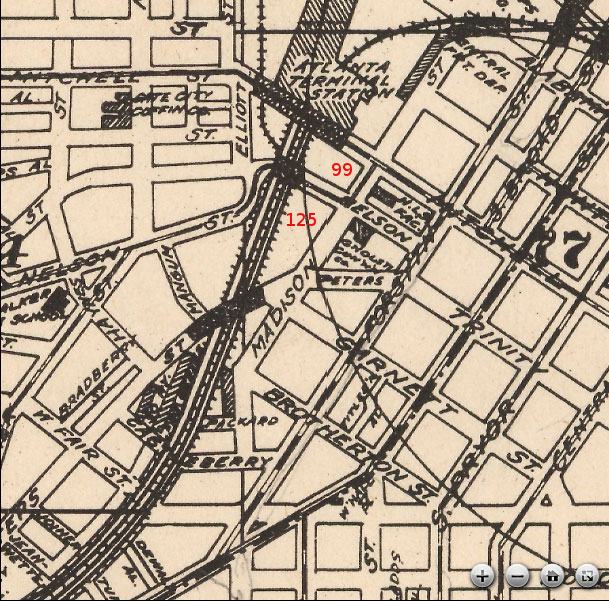
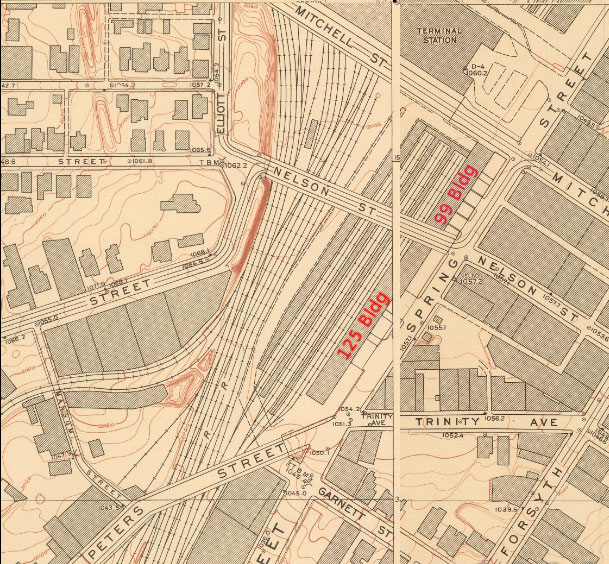
A retaining wall supporting Spring Street was located approximately thirty-five feet from the front edge of both buildings. This left a gap between the building and the street. Spring Street was approximately level with the second floor of both buildings. So in order to provide entry to the buildings from the Spring Street level, a series of bridges was constructed across the gap to provide pedestrian entry to each building and parking for company officials.
During 1928, the floors of the 99 and 125 buildings were extended upward. That made each building eight stories high. An enclosed walkway bridge was built between the buildings for access between buildings from the fourth to the seventh floors. A later modification allowed access between the 8th floor of both buildings. It was at that time that the offices of the Auditor, which were composed of freight accounts, station accounts, passenger accounts and several other departments were relocated from Washington, D.C.
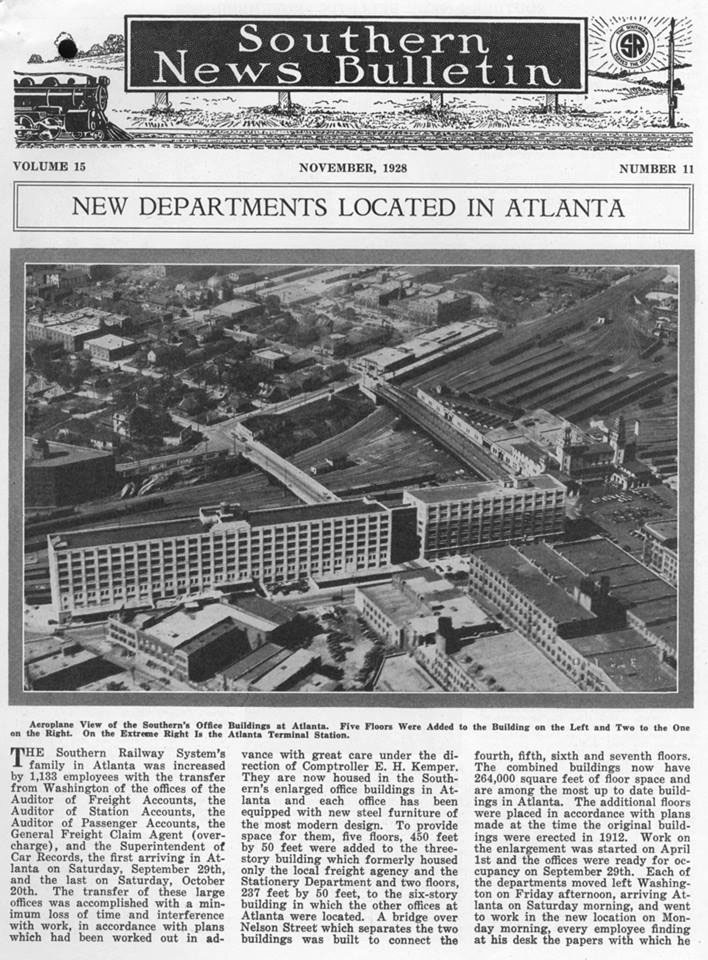
Engineering offices prior to 1964 were located in Charlotte, North Carolina, Knoxville, Tennessee, and Cincinnati, Ohio. These locations housed Eastern Lines, Central Lines and Western Lines respectively. In 1964 Southern relocated the three field engineering offices to Atlanta.
During the period of Southern Railway Company’s existence, until the 1982 merger with the Norfolk and Western Railway, Washington, DC was the corporate headquarters for Southern. After the formation of Norfolk Southern, NS gradually closed Southern’s old headquarters building and began consolidating departments to Norfolk, Virginia, Roanoke, Virginia and Atlanta. Because of space limitations in Atlanta, NS built a new six story office building south of the 125 Building that was known as the 185 Building. The six floor building was finished in 1984 and was built adjacent to what was known by Southern employees as the Bayer Aspirin Building. This building was converted to offices as well and became known as the 175 Building. Both buildings were located on Spring Street south of the Peters Street viaduct.
Having started with Southern Railway in September, 1973 in Valdosta, GA and moving to Atlanta the following year, I have witnessed first hand many changes made to the interior of the buildings, especially after the 1982 merger with the N&W, and a few more after the acquisition of Conrail in 1999. In fact, some departments had to be housed in space leased by NS in another part of downtown Atlanta.
One could almost get the feel of how the railroad was doing, based on the number of trains that passed by daily.
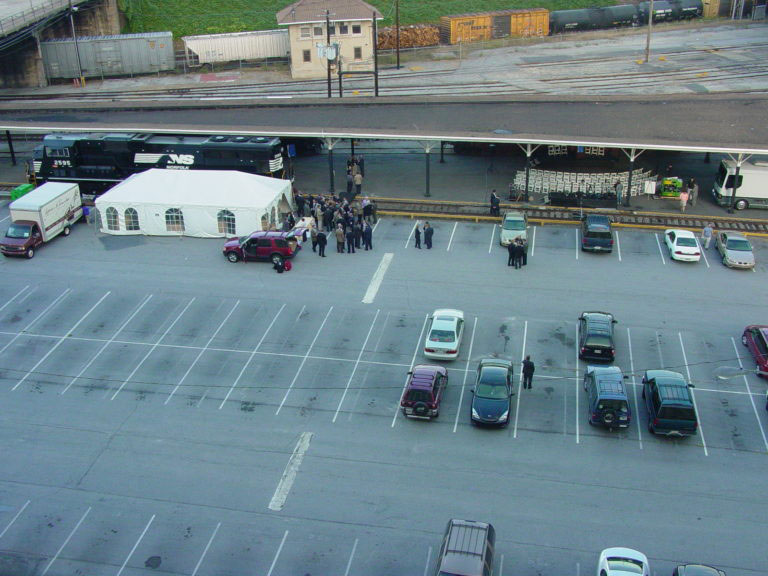
The outside appearance of the 99 and 125 buildings remained virtually unchanged with the exception of new windows installed on the west side of the buildings in the late 1970’s. However one noticeable change was the removal of the big Southern Railway neon signs. One was located on the roof of the north end of the 99 Building and the other on the roof of the south end of the 125 Building. The signs were lit at night until the 1972 energy crisis. From that time until its removal, they were never lit again.
July, 2005 marked another change for the building complex. That year Norfolk Southern vacated all offices from its Spring Street location and moved to an existing building at 1200 Peachtree Street, NE, that once housed the offices of AT&T. The move left uncertainty in the community as to the fate of the 99 and 125 buildings for a number of years. The buildings were not listed on the National Register of Historic Places and the concern for a while was that they could be torn down to make way for development of the area known as the “Gulch”.
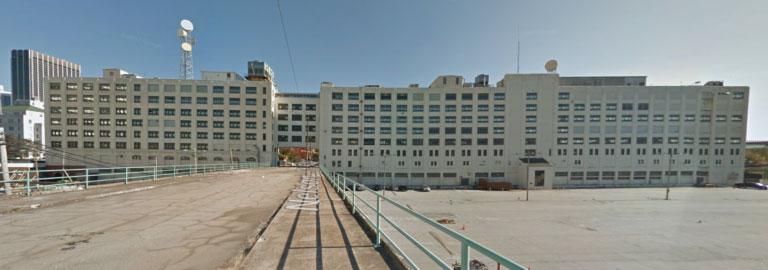
In 2017, a developer bought the entire building complex from Norfolk Southern for $25 million, including the Nelson Street bridge which has been closed for many years. Plans for the 99 and 125 buildings call for six or seven retailers, about 50,000 square feet of offices and hundreds of new residences. No plans have yet been determined concerning the buildings at 175 and 185 Spring Street which is now Ted Turner Drive. The rest of the story concerning the buildings is at https://atlanta.curbed.com/2018/8/27/17788102/northfolk-southern-building-downtown-cim-apartments-offices
For me, the 99 and 125 buildings hold many memories, from the first day I arrived there for work in 1974 to the day I retired in November, 2003. The one thing that was enjoyable along with the work was being able see and hear trains go by the building each day. One could almost get the feel of how the railroad was doing, based on the number of trains that passed by daily.
Doug Bess – Copyright 2018
Doug, the 185 blg. was first constructed as either a 3 or 4 story building and was first occupied in 1979 or 1980. I was in SR’s Safety Department representing MW&S. My office was in the 185 blg. until I became ADE on the Georgia Division late 1980. The additional floors were added after the merger with the N&W. Max Mitchell
Thanks Max.
What a wonderful story. As an Atlanta native, I well remember those huge SR signs on the top of each end of the buildings….at night their bright red letters could be seen for many blocks as one approached the downtown area. And of course, Terminal Station was right next door…my first train ride ever was in 1953 when my mother and I departed from that edifice to visit her sister in Columbus. We rode on the C. of GA .”Man O War:…I was about 4.
Greg Hodges, Richmond, VA.
I appreciate you sharing your memories of the Southern Railway’s office buildings. Unfortunately I arrived there too late to see the signs lit up but it must have been quite a sight.
Doug, This is a very interesting account of the Southern Railway would it be possible for me to republish this article in the NMRA British Region magazine Roundhouse in 2019?
Peter Bowen
Peter, thank you for your interest in the article for Roundhouse Magazine. You certainly have my permission to reprint it.
I don’t know what year the sign on top of 125 spring st came down but there was a working sign there in the late 70’s. I remember it flashed in green letters LOOK AHEAD LOOK SOUTH then in red letters SOUTHERN RAILWAY. Saw it many times at night coming in on trains from Macon.
I remember the buildings very well as I had to go into them numerous times as I worked on the Georgia division south end. I even made quite a few trips with Buster Posey, but I never saw the lights lit up on the roof. I do remember one time when I was in the building and I went out on one of the bridges as I was snooping around found numerous drawings prints and maps of the old Central Georgia, all of that stuff is probably long gone to a land fill.
Thanks for the memories.
WH Dunn
As a college senior in April 1971 I flew into Atlanta one evening for a “Plant Tour” and interview for a job as management trainee in the Maintenance of Way Department. As my flight descended, the “LOOK AHEAD LOOK SOUTH/SOUTHERN RAILWAY” sign welcomed me to a wonderful career that lasted 41 years.
Harold, I believe you and Ron Mack taught Roadway Basic classes in Birmingham. I was in one of your classes.
Just seeing your note 14 months later. Sorry for such a delay. Yes, I remember my days at the Training Center.
Harold, remember working with you in Manassas, VA when most of what was between Manassas and Alexandria was wooded. As I recall you were the “senior” trainee on station with previous railroad experience in passenger service. Hope you are enjoying your well earned retirement
The development by CIM has been pretty amazing so far and the Nelson Street Bridge started coming down today. I’m awaiting new renderings, but thank you for this! Living in Castleberry Hill since 2001 and owning a business on Nelson that shows off that bridge and the buildings every day, I appreciate this so much as well as that amazing photograph of the area from 1919!
I am a history buff!! LOVED THIS ARTICLE. Thanks so much for posting Carrie you are always on the ball. Keep up the excellent work.
Doug, Great article. Brings back memories of chilly days on the sixth floor of the 99 Spring Bldg, before the drafty windows were replaced. The view of the trains was exceptional.